Runes are a major IP sink.
If you’re getting into ranked League of Legends or just hit level 20, you should probably be thinking about your runes and rune pages. I’ve hand-selected the best starter runes, as well as how much IP you need to complete some beginner rune pages. If you’re on a strict IP budget, Tier 2 runes are only 1 IP apiece and will serve you acceptably until you can afford the good stuff: the tier 3 runes. Tier 2s are only 78% efficient by comparison, so try to save up!
If you’re a ranked player, you should definitely buy more rune pages to supplement your two ‘starter’ pages. Yikes–6300 IP per rune page. Wait for Riot to hold one of their two-for-one rune page sales, or just get a 7 rune page bundle if you want a lot of pages. (Check out our article on the fastest ways to earn IP if you want to speed up the process a bit.) The more rune pages you have, the better you can maximize your loadout against lane opponents and enemy team compositions.
Marks
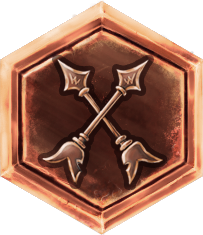 Unless you’re a low-damage support, marks are best used to boost your offensive stats. Attack damage marks are suitable for any AD champion, while magic penetration marks work for most AP champions. If you play tanky supports, you might consider investing in Greater Marks of Armor since you aren’t a vital damage dealer. Greater Marks of Precision (Hybrid Penetration) are costly, but they’re great for AP champions that auto attack in lane.
Unless you’re a low-damage support, marks are best used to boost your offensive stats. Attack damage marks are suitable for any AD champion, while magic penetration marks work for most AP champions. If you play tanky supports, you might consider investing in Greater Marks of Armor since you aren’t a vital damage dealer. Greater Marks of Precision (Hybrid Penetration) are costly, but they’re great for AP champions that auto attack in lane.
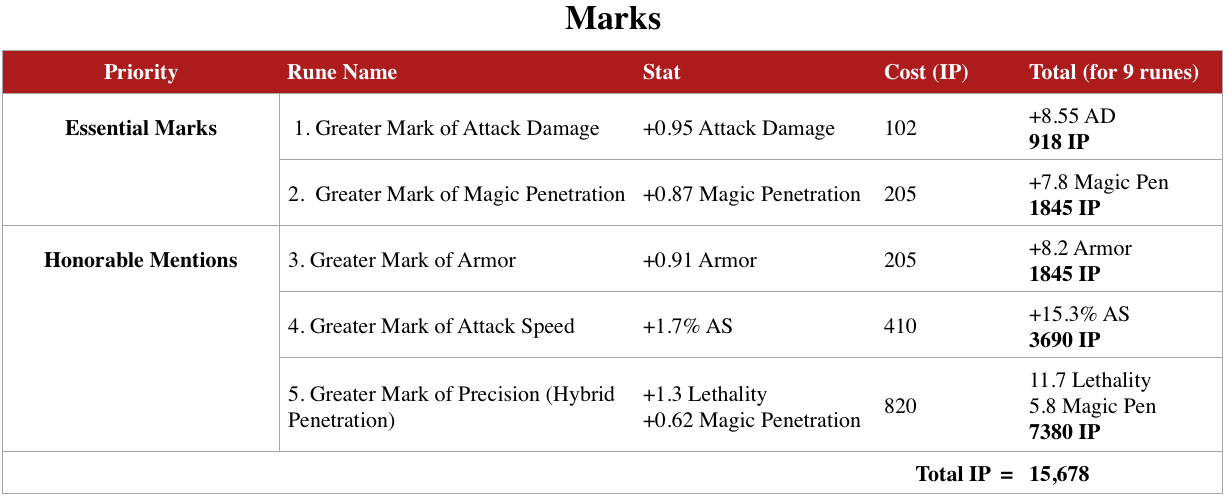
Glyphs
 Glyphs are the most versatile runes in League of Legends. They are generally best for providing magic resist or cooldown reduction, but are also occasionally useful for providing mage stats like ability power or mana. A common dilemma players face is whether they should use flat or scaling runes. Flat runes are better early game (varyingly between levels 6 and 9), but scaling runes catch up and become much stronger by level 18. If you’re trying to decide between flat versus scaling magic resists, generally go for flat resists if your lane opponent deals magic damage, but bring scaling resists if it’s the other lanes dealing magic damage. If you aren’t concerned about taking magic damage at all, use your glyph slot for cooldown reduction or mage stats.
Glyphs are the most versatile runes in League of Legends. They are generally best for providing magic resist or cooldown reduction, but are also occasionally useful for providing mage stats like ability power or mana. A common dilemma players face is whether they should use flat or scaling runes. Flat runes are better early game (varyingly between levels 6 and 9), but scaling runes catch up and become much stronger by level 18. If you’re trying to decide between flat versus scaling magic resists, generally go for flat resists if your lane opponent deals magic damage, but bring scaling resists if it’s the other lanes dealing magic damage. If you aren’t concerned about taking magic damage at all, use your glyph slot for cooldown reduction or mage stats.
I’m a huge proponent of flat cooldown reduction runes, but they’re expensive as hell, and most players don’t have 7380 IP lying around. Starting the game with 7.5% CDR is pretty valuable. For scaling CDR runes to reach equivalency, they would take until level 9. However, if you opt to go for scaling CDR, here’s a tip: since many builds naturally reach 30% CDR, you only need 6 scaling CDR runes to accomplish 10% CDR at level 18–remember, that’s your CDR cap. This leaves you with 3 rune slots to use on resists or mage stats.
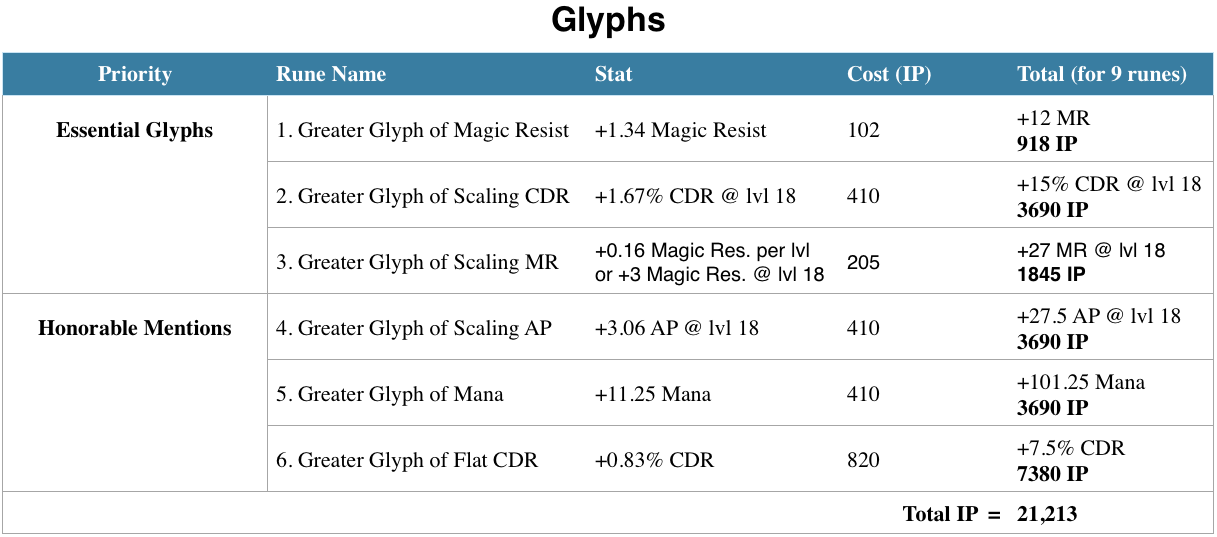
Seals
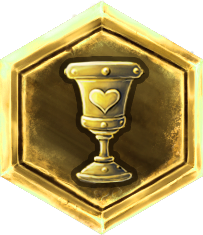 If I had to use one seal for the rest of my life it would be Greater Seals of Armor. Since minions, monsters, turrets, and auto attacks all deal physical damage, you’ll always benefit from having armor. However, against magic damage, health is always better than armor. Flat health seals are a good choice if your champion trades heavily pre-6, otherwise go for scaling health seals. Scaling health seals give a whopping 216 health at level 18! Now that’s what I call value.
If I had to use one seal for the rest of my life it would be Greater Seals of Armor. Since minions, monsters, turrets, and auto attacks all deal physical damage, you’ll always benefit from having armor. However, against magic damage, health is always better than armor. Flat health seals are a good choice if your champion trades heavily pre-6, otherwise go for scaling health seals. Scaling health seals give a whopping 216 health at level 18! Now that’s what I call value.
Greater Seals of Scaling Armor are rarely a good choice, but they’re worth experimenting with if you think your levels 1-6 against a physical damage dealer are easy. From level 7 onward, scaling armor seals outscale flat armor seals. Still, they’re one of the riskier choices. I only use scaling armor to complement armor quints.
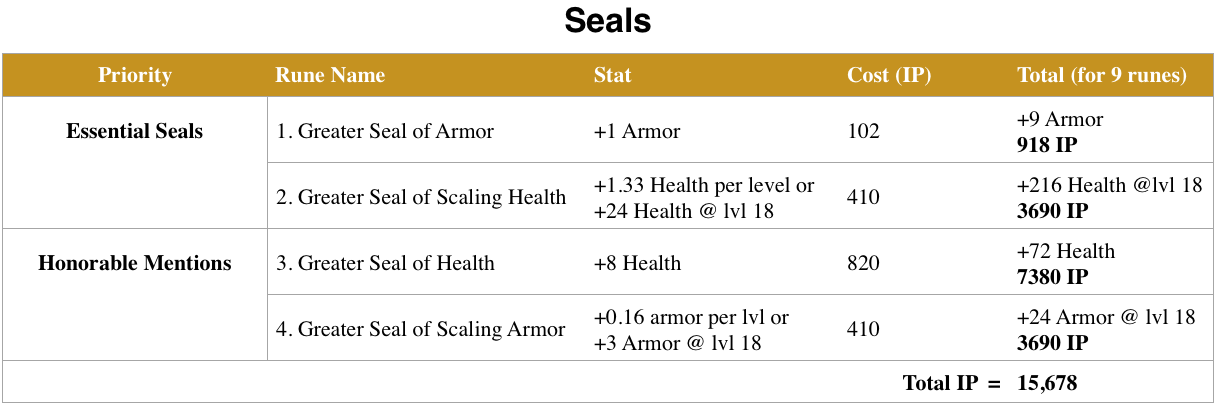
Quintessences
 Quintessences provide the most statistical variety: there are viable quint types in offensive, defensive, and utility categories. If you’re a theorycrafter like me, Quints will be a long-term IP sink for you. Buy the most important Quints first: attack speed, attack damage, and ability power. If you play a lot of Singed, Hecarim, or Ivern, movement speed quints will probably be on your must-buy list as well. Just don’t waste your time buying -5% time dead quints, because good players never die.
Quintessences provide the most statistical variety: there are viable quint types in offensive, defensive, and utility categories. If you’re a theorycrafter like me, Quints will be a long-term IP sink for you. Buy the most important Quints first: attack speed, attack damage, and ability power. If you play a lot of Singed, Hecarim, or Ivern, movement speed quints will probably be on your must-buy list as well. Just don’t waste your time buying -5% time dead quints, because good players never die.

Buying Runes on a Budget
Now that you’ve got a better sense of the most important runes in League of Legends, it’s time for a quick reality check: the total cost of all the runes I’ve listed in this article comes out to a whopping 67,941 IP.
You May Like
That’s a daunting number, especially for newer players, but if you’re looking to get the most bang for your buck, buy armor seals and magic resist glyphs first -you can reuse them on most of your pages. If you’re absolutely stuck with two pages, here are the two most versatile rune setups in existence (only 9,210 IP total), plus two somewhat spicier configurations to give you some ideas:

Having all 20 rune pages is the ultimate convenience: you can design ‘versus AD pages’ and ‘versus AP pages,’ for multiple roles, multiple champions, or you can even design fringe pages that exploit things like all-AD enemy comps. But don’t attempt to do this all at once. Runes and rune pages should be purchased incrementally. When it comes down to it, League of Legends runes are an investment for dedicated players. And if you’ve been playing League without runes? You’ll feel like you took off the training weights once you finally commit.
















